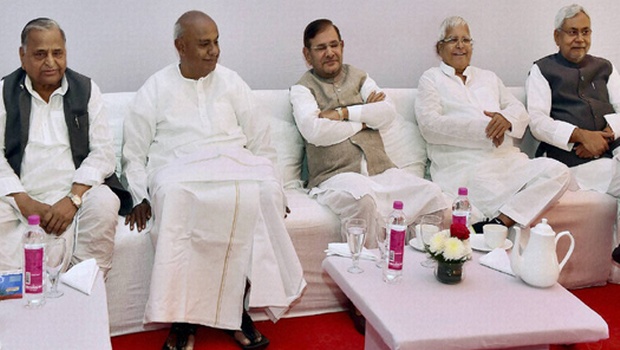New Delhi: Like drunks propping each other up, the new Lalu Prasad-Mulayam Singh-Nitish Kumar-Deve Gowda alliance against Narendra Modi is unlikely to be what god ordered for India. Even if they hang together, they are unlikely to make more than a regional impact.
On 7 November, the parties met in Delhi with the idea of hanging together since hanging separately did not yield them results in the Lok Sabha elections this year. Their message is “naya saal, nayi party”.
Now that a naya saal is just a month away, the alliance is likely to converge into a khichdi party. A name has been mentioned in The Economic Times: the Samajwadi Janata Dal, with Mulayam Singh as figurehead chief, and Nitish Kumar, Abhay Chautala and Deve Gowda likely to get key posts. What Lalu will do is not mentioned in report quoted here.
We can discount the Deve Gowda part of the alliance, for his party, the Janata Dal (Secular) looks like a has-been even in its home base of Karnataka. It is unlikely that any of the others can help him gain traction there. He will have to sink or swim on his own with his small Vokkaliga voter base. The addition of Om Prakash Chautala’s INLD, already given a thrashing by Modi in the recent Haryana vote, also can’t add much heft to the group which wants the create the magic of 1989, when they had signed up under VP Singh before the mandal-masjid fiasco ended it all.
The core of the proposed alliance is thus Lalu, Mulayam and Nitish, who run relatively strong parties built on an OBC base across the two of the biggest states in the Hindi heartland – Uttar Pradesh and Bihar, with 120 Lok Sabha seats between them. This is where Narendra Modi comprehensively defeated them in May 2014.
It is best to designate the Lalu-Mulayam-Nitish get-together as the Lemon alliance – an acronym derived from their initials LMN, which could also be an SMS short-form for Lemon.
The Lemon alliance, as the name suggests, is likely to be a lemon despite the fact that they made some gains in the byelections held after the Lok Sabha results in UP and Bihar. It has all of 15 MPs in parliament, including ILND’s two, and hardly in a position to take on the BJP.
The reasons why the alliance could be a lemon are the following.
One, it is built on the same caste arithmetic assumption that OBCs plus Muslims will be a winning combo in the Gangetic plain. This is exactly what Modi disproved in 2014. While the Yadav-Muslim alliance in UP held together, the Modi coalition of upper castes, lower OBCs and a segment of Dalits did better. The coalition did not hold as well in Bihar. While caste combos will continue to play a subtle role in all elections, the fact is people are breaking out of old straitjackets. Caste arithmetic will not add up as easily in future. Two plus two may not equal even four the next time, and one can be sure that the Modi-Shah duo will be planning to bust the Yadav vote bank the next time.
Two, a negative alliance against Modi will only work if there is strong anti-incumbency or if the alliance itself has a strong message of hope. But, if anything, it is the Samajwadi Party and the Janata Dal (United) that face an anti-incumbency mood in their states – after five years and 10 years of rule in UP and Bihar. Modi will be leading a party which will harness this anti-incumbency, if any, in 2017 and 2015.
Three, modern elections are turning presidential. They will be fought as much under a coherent and charismatic leadership as with caste and community-based coalitions. In this department, Modi is head and shoulders above the Lemon alliance, especially given their know suspicions about each other. Lalu and Mulayam vowed to fight all elections together in 2009, but after being outshone by the Congress in UP and Bihar, they barely combined for anything. Lalu and Nitish were sworn enemies till last year. Now, they are in bed to prove a point to Modi. It’s an affair on the rebound. The electorate is wise to these opportunistic groupings. It knows what happened to such khichdi alliances in 1997 and 1989.
Four, two of the alliance leaders are fit for the geriatric ward, and two are jailbirds, convicted for corruption. Mulayam Singh is 75 and doddering, and Deve Gowda is 81. Lalu is a convicted criminal and so is INLD’s Chautala. That leaves Nitish, 63, as a young knight in shining armour. One more defeat and he too will be consigned to the dustbin of history, but at least he has age on his side. Both he and Lalu will be around to see the turn of this decade in politics.
Five, the emergence of a strong OBC combo will consolidate votes at the other end. And let’s not forget what Mayawati may be upto with the Congress – not left out of the OBC party. If it’s a three-horse coalition race the next time, the advantage may still remain with the most coherent alliance of them all – the BJP’s.
Six, and this is what the lemon allies are forgetting. In the next two years, India’s business cycle is about to turn for the better. By 2019, the economy could be into overdrive. Even without heroic reforms by the Modi government, the economic tide will turn, making anti-incumbency a difficult platform from which to take on Modi in 2019. In 2009, five years of a booming economy helped the Congress to coast to victory with 206 seats.
It will need Modi to screw up his politics and economics badly for him to be a pushover in 2019. I doubt the lemon alliance can make anything beyond lemonade in Modi’s India.

